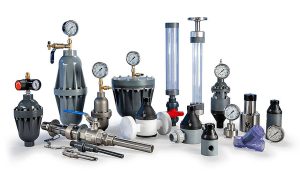Fluid handling systems are at the heart of modern industry, serving as the circulatory system for a wide range of processes. From chemical manufacturing and wastewater treatment to agriculture and food production, the ability to move fluids with precision and efficiency is a cornerstone of success. The science behind this movement is complex and multifaceted, involving an intricate interplay of mechanics, chemistry, and engineering. Understanding the principles of effective fluid handling is crucial for creating systems that are not only productive but also reliable and safe.
The Physics of Flow and Pressure
At the core of fluid handling is a deep understanding of fluid dynamics. This field of science explores how fluids behave when in motion. Pressure, flow rate, and viscosity are key variables that engineers must master. When a fluid moves through a pipe, it experiences friction and changes in pressure, which can impact the entire system. Pumps provide the necessary force to overcome these resistances and maintain a steady flow. However, the true science of a well-regulated system lies in how it manages pressure fluctuations and flow inconsistencies. Back pressure valves, for example, are essential components. They maintain a consistent back pressure on a pump’s discharge line, ensuring accurate flow rates and preventing siphoning. Without this control, the flow becomes unpredictable, undermining the precision of the entire operation.
Precision and Control Through Strategic Components
Achieving effective fluid handling requires more than just moving a liquid from one point to another. It demands precision, consistency, and control. This is where specialized accessories become indispensable. Pulsation dampeners, for instance, play a vital role in smoothing out the pressure spikes created by positive displacement pumps. These devices absorb the energy from each pump stroke, transforming a pulsating flow into a continuous, steady stream. This not only protects sensitive equipment downstream but also ensures the accurate and consistent delivery of fluids, which is critical in applications like chemical injection. Without a pulsation dampener, the system is subject to constant stress, leading to premature wear and potential failure.
The Role of Valves and Guards in Fluid Handling
The proper selection and placement of valves and guards are fundamental to the science of a robust fluid handling system. Pressure relief valves are a perfect example of a safety-critical component. They function as a mechanical safeguard, automatically opening to relieve excess pressure and protect pipes and equipment from over-pressurization. This simple yet effective mechanism prevents catastrophic system failures and protects personnel from potential harm. Similarly, injection valves ensure a one-way flow into a process line, preventing backflow and cross-contamination. This is especially important in chemical applications where mixing chemicals could lead to dangerous reactions. The thoughtful incorporation of these components is a hallmark of a scientifically sound fluid system.
Gauge guards also represent an important aspect of a high-performing system. These devices protect sensitive pressure gauges from corrosive chemicals, viscous fluids, or slurry-like materials. By isolating the gauge, they ensure that it provides accurate readings without the risk of damage. Accurate pressure readings are a cornerstone of effective fluid handling, as they provide critical data for monitoring system health and making informed operational adjustments. A gauge that fails due to exposure can lead to system-wide problems and potential hazards.
Maintaining System Health with Filtration
Even in a closed-loop system, fluids can carry debris and particulates that can cause significant damage. Y-strainers are a simple but scientifically proven solution to this problem. Positioned upstream of pumps and valves, these devices act as filters, catching solid particles before they can enter and damage sensitive components. By preventing blockages and wear, y-strainers contribute directly to the longevity and reliability of the entire system. A clean system is a well-operating system, and filtration is a non-negotiable step in maintaining peak performance. This focus on prevention is a core tenet of effective fluid handling.
Griffco Valve understands that the science of fluid handling extends beyond the pump itself. For decades, we have dedicated ourselves to manufacturing the highest quality accessories that ensure system integrity and performance. Our extensive experience across numerous applications and markets has made us a trusted partner for companies that demand excellence. We recognize that every component, no matter how small, has a significant impact on a system’s overall success and safety.
Our commitment to quality, combined with our personal and knowledgeable customer service, ensures that our clients receive the best products and support for their specific needs. We partner with them to ensure their systems operate at the highest possible standards, providing peace of mind and confidence in their operations. Ultimately, the science of fluid handling is about more than just moving fluids; it’s about doing so with precision, reliability, and an unwavering commitment to safety.
A system equipped with the right accessories is a system engineered for success. It minimizes downtime, reduces maintenance costs, and prevents potentially dangerous incidents. By investing in the highest quality components, you are not just buying a product—you are investing in the science of a superior fluid handling system.

